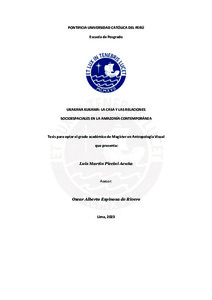| dc.contributor.advisor | Espinosa de Rivero, Oscar Alberto | |
| dc.contributor.author | Piccini Acuña, Luis Martin | |
| dc.date.accessioned | 2023-07-18T21:40:46Z | |
| dc.date.available | 2023-07-18T21:40:46Z | |
| dc.date.created | 2023 | |
| dc.date.issued | 2023-07-18 | |
| dc.identifier.uri | http://hdl.handle.net/20.500.12404/25390 | |
| dc.description.abstract | Esta investigación busca entender el punto de vista kukama sobre la participación de la casa en
su cosmoespacio a través de las relaciones socio espaciales que entreteje en una geografía
relacional afectiva dentro de una ontología compleja que involucra agentes humanos y no
humanos en la Amazonía peruana. Así se abre el debate del habitar en la Amazonía
contemporánea entramando un trabajo interdisciplinar entre la etnografía y la arquitectura
contribuyendo a hilvanar puentes que asocien las ciencias modernas y los conocimientos
indígenas. La investigación tomó lugar en poblaciones kukama de la cuenca del río Marañón en
el bajo Amazonas, recogiendo información mediante observación participante durante meses de
trabajo de campo inmersivo. Con un enfoque teórico antropológico, de la antropología del habitar
según Giglia, una revisión de la casa Cabila de Bourdieu y la crítica de Ingold al espacio desde una
interpretación de Certeuana, proponemos una nueva metodología que plasma los hallazgos
etnográficos de la casa en la planimetría arquitectónica, construyendo lo que llamaremos la
fábrica del espacio doméstico. En la cultura kukama, esta fábrica se expande más allá de la casa,
pero se articula a través de ella mediante relaciones interespecíficas complejas. La serpiente,
purawa, madre del rio, estructura el espacio doméstico como una columna vertebral. Generando
así tres bandas domésticas longitudinales, representadas por las casas, ukakana, que se
presentan como seres vivos que poseen como la purawa y los humanos: cuerpo, espíritu,
voluntad, afectividad y agencia predativa. Pudiendo adicionalmente molestarse, enfermarse,
cuidar de otros y matar. | es_ES |
| dc.description.abstract | This research seeks to understand the Kukama point of view on how the house is involved in its
cosmospace through the socio-spatial relationships that are woven into an affective relational
geography within a complex ontology that involves human and non-human agents in the
Peruvian Amazon. This opens the debate on living in contemporary Amazonia, intertwining an
interdisciplinary practice between ethnography and architecture, contributing to weave
connections that associate modern sciences and indigenous knowledge. The research took place
in the Kukama populations in the Marañón river basin in the lower Amazon. Information was
collected through participant observation during months of immersive field work. Using an
anthropological theoretical approach that combines: Anthropology of inhabiting according to
Giglia, a review of Bourdieu's Cabila house and Ingold's critique of space from a Certeuan
interpretation, we propose a new methodology that captures the ethnographic findings of the
house in planimetry architecture, establishing what we will call the fabric of the domestic space.
In the Kukama culture, this fabric extends beyond the house, but is articulated through it,
engaging complex interspecific relationships. The serpent, purawa, mother of the river,
assembles the domestic space as a spinal column. This generates three longitudinal domestic
bands that are represented by the houses, ukakana. The Kukama house is presented as living
beings that possess, like the purawa and human: body, spirit, will, affectivity and predatory
agency. They are also able to get upset, get sick, take care of others, and kill. | es_ES |
| dc.language.iso | spa | es_ES |
| dc.publisher | Pontificia Universidad Católica del Perú | es_ES |
| dc.rights | info:eu-repo/semantics/openAccess | es_ES |
| dc.rights.uri | http://creativecommons.org/licenses/by-nc-nd/2.5/pe/ | * |
| dc.subject | Prácticas sociales--Perú--Amazonía, Región | es_ES |
| dc.subject | Espacio doméstico--Perú--Amazonía, Región | es_ES |
| dc.subject | Arquitectura doméstica--Perú--Amazonía, Región | es_ES |
| dc.title | Ukakana kukama: la casa y las relaciones socioespaciales en la amazonía contemporánea | es_ES |
| dc.type | info:eu-repo/semantics/masterThesis | es_ES |
| thesis.degree.name | Magister en Antropología Visual | es_ES |
| thesis.degree.level | Maestría | es_ES |
| thesis.degree.grantor | Pontificia Universidad Católica del Perú. Escuela de Posgrado | es_ES |
| thesis.degree.discipline | Antropología Visual | es_ES |
| renati.advisor.dni | 06104457 | |
| renati.advisor.orcid | https://orcid.org/0000-0001-6605-013X | es_ES |
| renati.author.dni | 41431904 | |
| renati.discipline | 315117 | es_ES |
| renati.juror | Diez Hurtado, Antonio Alejandro | es_ES |
| renati.juror | Espinosa De Rivero, Oscar Alberto | es_ES |
| renati.juror | Castillo Guzman, Gerardo Manuel | es_ES |
| renati.level | https://purl.org/pe-repo/renati/level#maestro | es_ES |
| renati.type | https://purl.org/pe-repo/renati/type#tesis | es_ES |
| dc.publisher.country | PE | es_ES |
| dc.subject.ocde | https://purl.org/pe-repo/ocde/ford#5.04.03 | es_ES |







